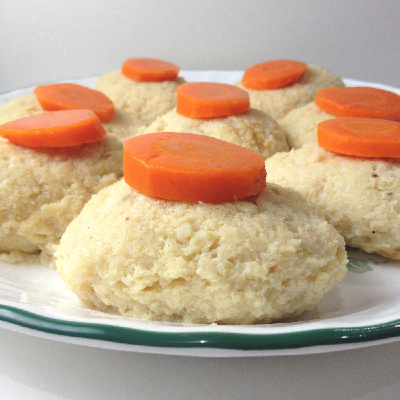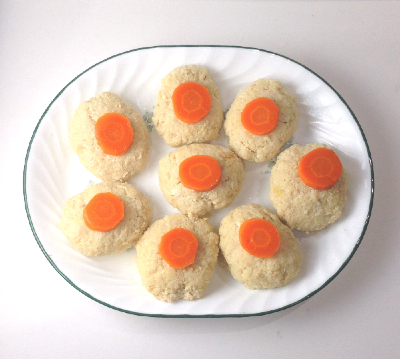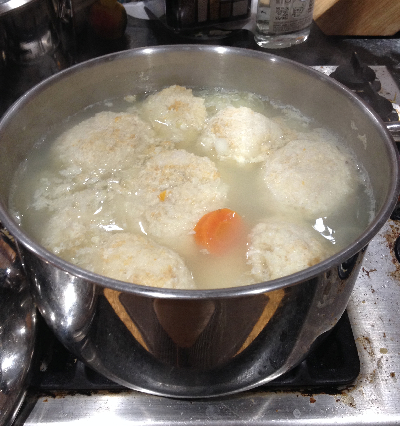It was a tradition for Rosh Hashana, Passover, or whatever in between. No matter where the holiday dinner was hosted – my mother’s, my brother’s, or my place – Mom always brought the Gefilte Fish and the chopped liver.
This was the benchmark against which all others were measured. In the grocery stores, shelves were loaded with jars filled with little beige loaves purporting to be gefilte fish. I passed them with idle curiosity. Occasionally, we’d be guests at friends’ homes where they busted out the jars and sometimes tried to dress them up, but they wouldn’t fool me. Hard as a rock, with a kind of tinny flavor and even stranger texture – this was absolutely not gefilte fish. No matter how much horseradish you dump on it. No. I still feel sorry for people who’ve never had the real thing, because most of them are haters without ever knowing that that’s not what it tastes like. I’m talking to you.
Please make this recipe today. Even if you’re not Jewish. It takes a little bit of time, but with a food processor, it’s easy to do. You (and your family) will never eat that stuff out of the jars ever again. At least, not willingly.
Traditional Sweet Gefilte Fish
(makes about 12 portions)
Ingredients:
Broth:
- 2 large carrots, peeled and sliced into coins, or on the bias
- 1 large onion, peeled and sliced
- 1 Tbs. salt
- 1/2 tsp. ground white pepper
Water (see preparation instructions)
Fish:
- 2 lbs white fish filets
- 2 large eggs, hardboiled, peeled, and cut in half
- 1 small onion, peeled and cut into quarters
- 3/4 cup ice water
- 2 large eggs, raw
- 3/4 cup matzo meal
- 1/3 – 1/2 cup granulated cane sugar
- 2 tsp. kosher salt
- 1/2 tsp. ground white pepper
Preparation:
Place the onions and carrots in the bottom of a 6 – 8 quart pot (not a tall-sided stockpot). Using a large measuring cup or a pitcher, slowly add water to the pot without disturbing the vegetables at the bottom, until the pot is about half-full. Add the seasonings, and bring the water to a boil. Cover the pot and reduce the heat until the broth is just simmering.
Cut each fish filet into four pieces.
Have a large mixing bowl ready. Using a large food processor fitted with the metal blade, and pulsing, chop the fish together with the hardboiled eggs, the raw eggs, and the small onion. I like to put in several pieces of fish with a quarter of the onion and a half of the hardboiled egg at a time, alternating with 1/4 cup of the ice water, and finishing with the raw eggs, scraping down the side of the processor’s work bowl between additions. If your food processor is not large enough, do this in batches, making sure that the end result is smooth and that there are no “chunks”.
Empty the contents of the food processor into the large mixing bowl. Add the matzo meal, sugar, salt and pepper, and mix well. This is the point when we check for seasoning: Take a bit of the batter, about the size of a nickel (or a Euro, if you’re reading this elsewhere), and drop it into the now-simmering broth. Let it poach for about 5 minutes. Remove it from the broth and let it cool for a few minutes. Now, take a bite. Does it need more salt? Is it sweet enough? Would you like another pinch of salt? Another tablespoon or two of sugar? If you add more of anything to the batter, make sure it’s well-incorporated and repeat the taste test. When you’re happy with it, cover the bowl and refrigerate the batter for at least one hour.
Form the chilled batter into patties about 1/2″ – 3/4″ thick and gently place them into the simmering broth. Use your hands. Fine. Wear gloves if you’re squeamish. Using that measuring cup or pitcher, gently add more water, if necessary, to raise the broth level to just cover the fish patties. Avoid pouring water directly onto the fish patties! Aim for in between. Bring the pot back up to a boil, then partially cover the pot with its lid and reduce the heat until it is just simmering.
Cook at a simmer for 1-1/2 hours. Remove the pot from the heat, and use a slotted spoon to remove the fish patties from the broth, onto a platter. Use the “good” dishes. Blot up any liquid from the plate with a paper towel. Fish out the prettiest carrot slices from the pot and garnish each patty. Cover the plate with plastic wrap and chill thoroughly before serving.
If you wish to save the broth, strain it into a clean bowl, using a fine strainer lined with several thicknesses of cheesecloth.
Serve chilled with red horseradish (horseradish mixed with beets) on the side.
~~~~~~~~~~~~
*Notes:
I call this “Mom’s Traditional Sweet Gefilte Fish”, but of course Mom never owned a food processor. She used a heavy meat grinder and then chopped it all yet again in a wooden bowl with one of those two-bladed choppers. That’s how she made her chopped liver, too. To this day, I’m convinced that’s how she got bursitis in her shoulder. That, and hand-grating potatoes on a box grater for kugels and latkes. We have the technology, people. Use it!
This recipe is easily doubled for a big crowd. Or if you want lots of leftovers. Which you will.
You can make the Gefilte Fish several days ahead of time – it’s a sturdy dish and only gets better with time.
Recommended fishes are cod, whitefish, or pike, or any combination of these. For this batch, I used all cod.
Of course you want the freshest fish possible. I will not, however, look down my nose at you if you bought frozen filets. I won’t tell anyone. Just make sure that they’re thawed completely and wiped dry with a paper towel before you begin. If you happen to be buying the fish fresh, however, ask your fishmonger to put the skin and bones in a separate bag for you. If you have the fish skin and bones, put those in the pot first, then cover with the onion slices, followed by the carrot slices. This will mostly protect your fish patties from getting all that nasty junk all over them when they’re poaching, while adding a lot of flavor and body to your broth. This will also transform your broth into actual “stock”, which – if you’re very lucky – will gel when it’s refrigerated later. Really delicious when mopped up with chunks of challah! Don’t get all upset if the transformation doesn’t happen. Even Mom’s didn’t gel all the time. Sometimes it did, and sometimes it didn’t – don’t stress it.
~~~~~~~~~~~~
Your New Year just started tasting a lot sweeter. L’Shana Tova!





I know… I am not Jewish… but I happen to love gefilte fish. I had it the first time as a child at a Jewish friends home and fell in love. I haven’t ever tried to make it though. I should… my daughter is really interested in Jewish history and tradition… and has been reading a lot about it. Maybe we’ll make some from your recipe so she can try it. She recently said she would like to try observing Shabbat one of these days to see what it’s like. If we do… I will be hitting you up with a boatload of questions, I’m sure. <3
I think it’s terrific that your daughter has such a strong interest, and I know your family are adventurous eaters, so I am happy to answer any questions you have. And you don’t have to be Jewish to cook and enjoy good food! 🙂
… I have never had it…. :/ looks yummy tho…:)
it does look good Renee
My Bubby passed away recently and this is her recipe exactly!! I am going to try to recreate it for my family this year. I read somewhere if you put the fish bones and skins in cheese cloth it wont murky up the fish. Do you think that will work?
Also, my Bubby used to put sugar in the water as well. Have you ever heard of that?
Thanks so much for sharing this recipe
PS- If you have a recipe for a potato kugel I would really appreciate! Sounds like your recipes are similar to ours 🙂
Hi, Randi – First, my condolences on your Bubby’s passing. I’m sure she’ll be missed so much, particularly around the holidays. I’ve always believed that food evokes memories, and I’m glad to hear that her recipe is so similar to my Mom’s. 🙂 I’ve never tried the cheesecloth trick, but if nothing else, it will surely help keep the vegetables and fish stay “clean”. I’ve never put sugar in the water, either, and I frankly don’t think this recipe needs it. The onions and carrots in the broth should make it sweet enough. If, after tasting your sample you think it’s not sweet enough, feel free to add a couple of tablespoons of sugar to the broth. That’s the beauty of these recipes – there’s always a little something you can do to make them your own.
Of course I have a recipe for potato kugel! You’ll find it here: http://flamingomusings/2013/09/traditional-potato-kugel-potato-pudding.html. I hope it’s what you’re looking for. You may want to follow me on Pinterest, too. There’s a group board with lots of Passover recipes, and a board of my posted traditional Jewish recipes. Or just do a search right here for Passover or Jewish Holiday recipes.
Thanks for stopping by and commenting – I’m always available to answer questions and offer helpful hints. 🙂
Ahhhhh!!! I made it and it all fell apart in the broth! Is there anyway to salvage it?
Hi, Heather! I’m sorry this happened to you! Sounds like there may have been too much liquid in your mixture, or your fish had a fairly high water content. I would suggest gathering as much of the disintegrated batter together as possible, and try to remake it as follows: Beat one large egg in a measuring cup. Add some of the beaten egg plus one tablespoon of matzo meal and mix thoroughly. Keep doing that until your mixture is pretty firm (like meatloaf consistency). Refrigerate it for another hour, then remake the patties and add gently to the simmering broth and poach for another 30 minutes. The patties should feel pretty firm, not soft. Turn off the heat and remove the pot from the hot burner. Allow them to cool in the broth for 30 minutes before gently removing them to a platter. Cover with plastic wrap and refrigerate promptly.